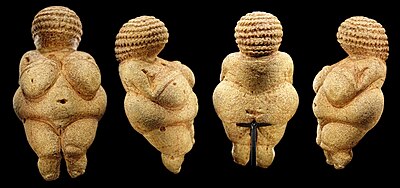Venus of Willendorf
| Venus of Willendorf | |
|---|---|
The Venus of Willendorf is an 11.1-centimetre-tall (4.4 in)
Dating
The figure is associated with the
Interpretation and purpose

Similar sculptures, first discovered in the nineteenth and early twentieth centuries, are traditionally referred to in archaeology as "Venus figurines", due to the widely held belief that depictions of nude women with exaggerated sexual features represented an early fertility deity, perhaps a mother goddess. The reference to Venus is metaphorical, since the figurines predate the mythological figure of Venus by many thousands of years. Some scholars reject this terminology, instead referring to the statuette as the "Woman of" or "Woman from Willendorf".[9]

Very little is known about the Venus' origin, method of creation, or cultural significance; however, it is one of numerous "
Catherine McCoid and LeRoy McDermott hypothesize that the figurines may have been created as self-portraits by women.[12] This theory stems from the correlation of the proportions of the statues to how the proportions of women's bodies would seem if they were looking down at themselves, which would have been the only way to view their bodies during this period. They speculate that the complete lack of facial features could be accounted for by the fact that sculptors did not own mirrors. This reasoning has been criticized by University of California anthropologist Michael S. Bisson, who notes that water pools and puddles would have been readily available natural mirrors for Paleolithic humans.[attribution needed]
Stone's source
Research published in 2022 indicates that the closest and most likely source of the oolite used is on the other side of the Alps in northern Italy, near Lake Garda. A lesser possibility is that it came from a site in eastern Ukraine some 1,600 km (1,000 mi) away.[2]
While the former has the highest statistical probability, the latter is closer to sites in southern Russia where similarly styled figurines have been found. In either case, this raises questions regarding the mobility of ancient populations.[2]
See also
- Art of the Upper Paleolithic
- List of Stone Age art
- History of nude art
References
- ^ a b Antl-Weiser, Walpurga (2009). "The time of the Willendorf figurines and new results of palaeolithic research in Lower Austria". Anthropologie. 47 (1–2). Brno: 131–141. Archived from the original on 2021-03-22. Retrieved 2019-09-27.
- ^ PMID 35228605.
- ^ Philip R. Nigst, Paul Haesaerts, Freddy Damblon, Christa Frank-Fellner, Carolina Mallol, Bence Viola, Michael Götzinger, Laura Niven, Gerhard Trnka, and Jean-Jacques Hublin: Early modern human settlement of Europe north of the Alps occurred 43,500 years ago in a cold steppe-type environment. PNAS October 7, 2014 111 (40) 14394-14399. doi:10.1073 /pnas.1412201111.
- ^ Venus of Willendorf Archived 2007-09-27 at the Wayback Machine Christopher L. C. E. Witcombe, 2003.
- ISBN 978-1-133-95122-3
- ^ Antl-Weiser, Walpurga. "The anthropomorphic figurines from Willendorf" (PDF). Wissenschaftliche Mitteilungen Niederösterreichisches Landesmuseum. 19: 19–30. Archived (PDF) from the original on 2014-10-21. Retrieved 2012-12-24.
- ^ Bibby, Geoffrey (1956). The Testimony of the Spade. New York: Alfred A. Knoff. p. 139.
- ^ Witcombe, Christopher (2003) Venus of Willendorf Archived 2004-04-03 at the Wayback Machine, retrieved 2008
- ^ Venus of Wllendorf Archived 2021-03-10 at the Wayback Machine, Encyclopædia Britannica; Dictionary of Women Artists Archived 2021-03-10 at the Wayback Machine.
- ^ ISBN 978-1-133-94533-8.)
{{cite book}}: CS1 maint: multiple names: authors list (link - ^ "Woman from Willendorf" Archived 2007-10-05 at the Wayback Machine. Christopher L. C. E. Witcombe, 2003: "The rows are not one continuous spiral but are, in fact, composed in seven concentric horizontal bands that encircle the head and two more horizontal bands underneath the first seven on the back of the head."
- S2CID 144914396.
External links
| External videos | |
|---|---|
- Christopher L. C. E. Witcombe, "Women in Prehistory:Venus of Willendorf".
- Don Hitchcock (Don's Maps): "Venus figures from the Stone Age - The Venus of Willendorf"
- The Invisible Sex: Uncovering the True Roles of Women in Prehistory by J.M. Adovasio, Olga Soffer and Jake Page, ISBN 978-0-06-117091-1, gives a new 'view' of headdress as possible model for weaving a basket; Lauran Miller review at Salon.com: [1]
- 3D model of the Venus of Willendorf in the 3D museum of the Natural History Museum Vienna
